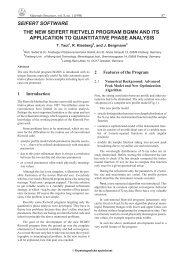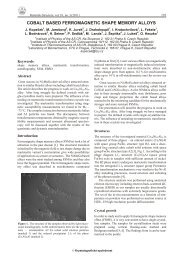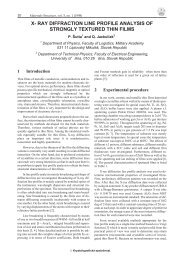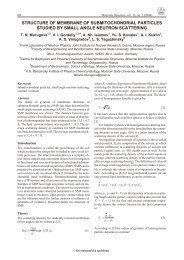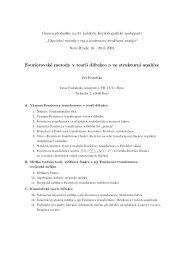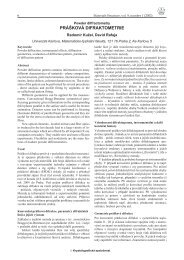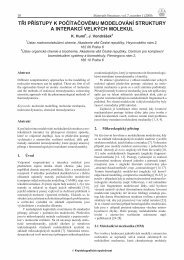tertiary structure of proteins involved in the bacillus subtilis cell ...
tertiary structure of proteins involved in the bacillus subtilis cell ...
tertiary structure of proteins involved in the bacillus subtilis cell ...
You also want an ePaper? Increase the reach of your titles
YUMPU automatically turns print PDFs into web optimized ePapers that Google loves.
I. Barák, K. Muchová, P. Florek and Z. Chromiková 15<br />
<strong>in</strong>teract with <strong>the</strong> 1-he lix <strong>of</strong> Spo0B. This <strong>in</strong> ter ac tion aligns<br />
<strong>the</strong> histid<strong>in</strong>e <strong>of</strong> Spo0B with <strong>the</strong> aspartate <strong>of</strong> Spo0F <strong>in</strong> cor -<br />
rect con fig u ra tion and dis tance for phosphotransfer. The<br />
hy dro pho bic sur face <strong>of</strong> Spo0F com prised <strong>of</strong> hy dro pho bic<br />
res i dues, Ile15, Leu18, Pro105, Phe106 and Ile108, is <strong>in</strong> -<br />
volved <strong>in</strong> this <strong>in</strong> ter ac tion. S<strong>in</strong>ce <strong>the</strong> struc ture <strong>of</strong> Spo0B is<br />
very sim i lar to <strong>the</strong> struc ture <strong>of</strong> histid<strong>in</strong>e sen sor k<strong>in</strong> ases, <strong>the</strong><br />
Spo0B-Spo0F struc ture should be viewed as a model for<br />
re sponse reg u la tor-sen sor k<strong>in</strong>ase <strong>in</strong> ter ac tions and <strong>the</strong>se six<br />
highly con served res i dues may play a key role <strong>in</strong> this <strong>in</strong> ter -<br />
action.<br />
Spo0A mas ter con trol for en try <strong>in</strong>to sporulation<br />
The fi nal ac cep tor <strong>of</strong> phos phate mi gra tion via Spo0F and<br />
Spo0B is Spo0A, <strong>the</strong> re sponse reg u la tor and key con trol el -<br />
e ment <strong>in</strong> <strong>the</strong> de ci sion to sporulate [2]. Spo0A con sists <strong>of</strong><br />
two do ma<strong>in</strong>s, <strong>the</strong> N-ter mi nal phosphoacceptor (re ceiver)<br />
do ma<strong>in</strong> and <strong>the</strong> C-ter mi nal DNA-b<strong>in</strong>d <strong>in</strong>g (effector) do -<br />
ma<strong>in</strong> [9] con nected by a flex i ble l<strong>in</strong>ker pep tide. As <strong>the</strong><br />
DNA-b<strong>in</strong>d <strong>in</strong>g do ma<strong>in</strong> is ac tive af ter re moval <strong>of</strong> <strong>the</strong> N-ter -<br />
mi nal do ma<strong>in</strong>, this re ceiver do ma<strong>in</strong> is thought to <strong>in</strong> hibit <strong>the</strong><br />
effector do ma<strong>in</strong> and this auto<strong>in</strong>hibition is over come by<br />
conformational changes fol low <strong>in</strong>g phosphorylation <strong>of</strong> <strong>the</strong><br />
N-ter mi nal do ma<strong>in</strong>. The crys tal struc ture <strong>of</strong> N-Spo0A was<br />
de ter m<strong>in</strong>ed <strong>in</strong> both phosphorylated and unphosphorylated<br />
forms [6, 10]. The over all fold <strong>of</strong> N-Spo0A per fectly<br />
matches <strong>the</strong> struc tures <strong>of</strong> <strong>the</strong> reg u la tory do ma<strong>in</strong>s <strong>of</strong> o<strong>the</strong>r<br />
re sponse reg u la tors. The struc ture <strong>of</strong> N-Spo0A~P re vealed<br />
that phosphorylation <strong>of</strong> aspartate 55 leads to con -<br />
formational changes at <strong>the</strong> ac tive site (Fig. 2B). The re ori -<br />
en ta tion <strong>of</strong> <strong>the</strong> Thr84 hydroxyl group to wards <strong>the</strong><br />
phosphoryl group is ac com pa nied by move ment <strong>of</strong> a side<br />
cha<strong>in</strong> <strong>of</strong> Phe103 from a sol vent ex posed po si tion <strong>in</strong>to <strong>the</strong><br />
pro te<strong>in</strong> core. S<strong>in</strong>ce <strong>the</strong>se ac tive-site res i dues are highly<br />
con served among re sponse reg u la tors and sim i lar changes<br />
were ob served <strong>in</strong> <strong>the</strong> struc tures <strong>of</strong> o<strong>the</strong>r ac ti vated re sponse<br />
reg u la tors [5, 11], this "ar o matic switch" could rep re sent a<br />
gen eral mech a nism <strong>of</strong> sig nal prop a ga tion through <strong>the</strong> pro -<br />
te<strong>in</strong> fol low <strong>in</strong>g aspartate phosphorylation. More over,<br />
mutational and bio chem i cal stud ies sug gest that Phe103<br />
could be <strong>in</strong> volved <strong>in</strong> dimer for ma tion <strong>of</strong> Spo0A af ter<br />
phosphorylation (un pub lished data).<br />
Re cently, struc tures <strong>of</strong> <strong>the</strong> C-ter mi nal do ma<strong>in</strong> <strong>of</strong><br />
Spo0A [12] and C-Spo0A <strong>in</strong> com plex with DNA [13] also<br />
were solved. The C-Spo0A (Fig. 2C) forms a large he li cal<br />
as sem bly com pris <strong>in</strong>g <strong>of</strong> six -helices (A-F) connected by<br />
short pep tides. The struc ture con ta<strong>in</strong>s a clas si cal he lixturn-<br />
he lix (he li ces C and D) as a DNA b<strong>in</strong>d <strong>in</strong>g mo tif. He li -<br />
ces A, B and F form a three-he li cal bun dle lo cated atop <strong>the</strong><br />
HTH and he lix E pro trudes from <strong>the</strong> bun dle op po site <strong>the</strong><br />
HTH. The res i dues <strong>in</strong> volved <strong>in</strong> con tact with A sub unit <strong>of</strong><br />
RNA polymerase <strong>in</strong> <strong>the</strong> transcription <strong>in</strong>itiation complex are<br />
sit u ated at <strong>the</strong> op po site end <strong>of</strong> <strong>the</strong> DNA rec og ni tion he lix<br />
and form <strong>in</strong> con trast with <strong>the</strong> rest <strong>of</strong> <strong>the</strong> struc ture a flex i ble<br />
and mo bile seg ment. The crys tal struc ture <strong>of</strong> C-Spo0A <strong>in</strong><br />
com plex with its tar get DNA (Fig. 2C) re vealed that two<br />
mol e cules form a dimer upon b<strong>in</strong>d <strong>in</strong>g to <strong>the</strong> tan dem b<strong>in</strong>d -<br />
<strong>in</strong>g sites on <strong>the</strong> DNA. The mol e cules are bound <strong>in</strong> head to<br />
tail ar range ment such that <strong>the</strong> C-ter mi nus <strong>of</strong> one mol e cule<br />
(he lix F) <strong>in</strong> ter acts with <strong>the</strong> N-ter mi nus <strong>of</strong> an o<strong>the</strong>r (he lix B).<br />
He lix F <strong>of</strong> one mol e cule and he li ces A and B <strong>of</strong> <strong>the</strong> sec ond<br />
mol e cule form a C-Spo0A dimer <strong>in</strong> ter face. Such di me -<br />
rization should sta bi lize <strong>the</strong> pro te<strong>in</strong>-DNA com plex. Also<br />
analytical ultracentrifugation and gel filtration experiments<br />
re vealed dimerization <strong>of</strong> en tire Spo0A af ter phospho -<br />
rylation [14]. These re sults <strong>in</strong> di cate that dimerization af ter<br />
phosphorylation is me di ated pr<strong>in</strong> ci pally by <strong>the</strong> re ceiver do -<br />
ma<strong>in</strong> prob a bly fol lowed by dimerization <strong>of</strong> <strong>the</strong> effector do -<br />
ma<strong>in</strong> bound on DNA. Ob ta<strong>in</strong>ed struc tural and bio chem i cal<br />
data pro vide an im por tant frame work for fur <strong>the</strong>r <strong>in</strong> ter pre ta -<br />
tion <strong>of</strong> <strong>the</strong> mutational data <strong>of</strong> Spo0A and thus un der stand -<br />
<strong>in</strong>g <strong>of</strong> <strong>the</strong> bi o log i cal func tion <strong>of</strong> Spo0A at <strong>the</strong> mo lec u lar<br />
level.<br />
O<strong>the</strong>r pro te<strong>in</strong>s <strong>in</strong> volved <strong>in</strong> <strong>in</strong>i ti a tion <strong>of</strong><br />
sporulation<br />
To en sure that spore for ma tion is <strong>the</strong> only way which en -<br />
ables <strong>the</strong> bac te rium is able to over come un fa vour able en vi -<br />
ron men tal con di tions, <strong>the</strong> en try <strong>in</strong>to sporulation is<br />
pre cisely con trolled not only by <strong>the</strong> above men tioned com -<br />
po nents <strong>of</strong> phosphorelay, but also by o<strong>the</strong>r pro te<strong>in</strong>s.<br />
Among <strong>the</strong>se, an im por tant role be longs to <strong>the</strong> sporulation<br />
<strong>in</strong> hib i tor S<strong>in</strong>R and its an tag o nist S<strong>in</strong>I [15]. S<strong>in</strong>R is a<br />
tetrameric DNA b<strong>in</strong>d <strong>in</strong>g pro te<strong>in</strong> that con trols sporulation<br />
di rectly through re pres sion <strong>of</strong> spo0A and stage II spo -<br />
rulation genes, spoIIA, spoIIE and spoIIG. For spo rulation<br />
to pro ceed, <strong>the</strong> ac tiv ity <strong>of</strong> S<strong>in</strong>R must be switched <strong>of</strong>f. This<br />
is brought about by <strong>the</strong> ac tion <strong>of</strong> S<strong>in</strong>I which forms<br />
S<strong>in</strong>I-S<strong>in</strong>R com plex that is un able to b<strong>in</strong>d to DNA and<br />
<strong>the</strong>re fore <strong>the</strong> re pres sive ef fects <strong>of</strong> S<strong>in</strong>R on tran scrip tion are<br />
re lieved. The crys tal struc ture <strong>of</strong> this heterodimer [16] re -<br />
vealed an -he li cal as sem bly <strong>of</strong> two do ma<strong>in</strong>s <strong>of</strong> ap prox i -<br />
mately equal size, an oligomerisation do ma<strong>in</strong> and a<br />
DNA-b<strong>in</strong>d <strong>in</strong>g do ma<strong>in</strong>. The oligomerisation do ma<strong>in</strong> is<br />
formed by four -helices, two from <strong>the</strong> C-term<strong>in</strong>al residues<br />
<strong>of</strong> S<strong>in</strong>R and two from <strong>the</strong> cen tral res i dues <strong>of</strong> S<strong>in</strong>I (Fig. 2D).<br />
Re cently, struc ture <strong>of</strong> an o<strong>the</strong>r pro te<strong>in</strong>, Obg , a Spo0B-as so -<br />
ci ated GTP b<strong>in</strong>d <strong>in</strong>g pro te<strong>in</strong>, <strong>in</strong> volved <strong>in</strong> <strong>the</strong> sporulation<br />
path way, was solved [17]. This struc ture re vealed <strong>the</strong><br />
unique ar chi tec ture <strong>of</strong> a GTP b<strong>in</strong>d <strong>in</strong>g pro te<strong>in</strong> and to ge<strong>the</strong>r<br />
with biochemical analysis suggests a potential role for this<br />
pro te<strong>in</strong> <strong>in</strong> <strong>the</strong> life cy cle <strong>of</strong> B. <strong>subtilis</strong>.<br />
Pro te<strong>in</strong>s <strong>in</strong> volved <strong>in</strong> <strong>the</strong> ac ti va tion <strong>of</strong> first<br />
compartment specific sigma factor - F<br />
The first clear mor pho log i cal fea ture <strong>of</strong> sporulation is <strong>the</strong><br />
for ma tion <strong>of</strong> an asym met ric sep tum (Fig. 1A) that bi sects<br />
<strong>the</strong> bac te rial <strong>cell</strong> <strong>in</strong>to two un equally sized com part ments,<br />
<strong>the</strong> larger mo<strong>the</strong>r <strong>cell</strong> and <strong>the</strong> smaller forespore. The proper<br />
po si tion <strong>in</strong>g <strong>of</strong> this sporulation sep tum is de pend ent on<br />
Spo0A ac tiv ity, which me di ates <strong>the</strong> as sem bly <strong>of</strong> di vi sion<br />
pro te<strong>in</strong>s near <strong>the</strong> <strong>cell</strong> pole <strong>in</strong> stead <strong>of</strong> at mid-<strong>cell</strong>. Such po si -<br />
tional switch could be par tially trig gered through <strong>the</strong> ac tiv -<br />
ity <strong>of</strong> <strong>the</strong> sporulation spe cific pro te<strong>in</strong> SpoIIE, also a<br />
com po nent <strong>of</strong> <strong>the</strong> sporulation sep tum, that is ex pressed as a<br />
re sult <strong>of</strong> Spo0A ac tiv ity [18, 19, 20, 21]. The cen tral do -<br />
ma<strong>in</strong> <strong>of</strong> SpoIIE is <strong>in</strong> volved <strong>in</strong> oligomerization <strong>of</strong> <strong>the</strong> pro -<br />
te<strong>in</strong> and it is re spon si ble for <strong>in</strong> ter ac tion with FtsZ, <strong>the</strong><br />
pro te<strong>in</strong> es sen tial for <strong>cell</strong> di vi sion [22, 23]. SpoIIE pro te<strong>in</strong><br />
can dephosphorylate SpoIIAA-P and thus it plays a cru cial<br />
Krystalografická spoleènost



